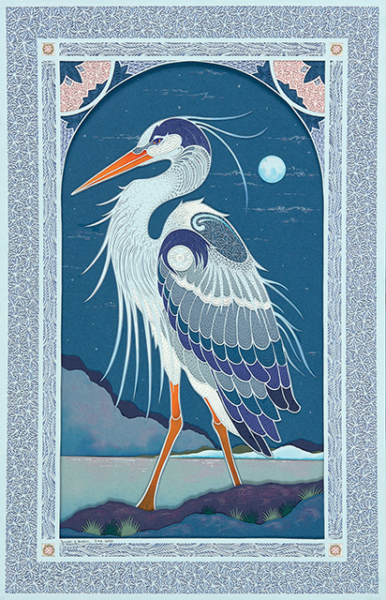Jennifer Hudson creates multidimensional stories depicting forests of wildlife and flora in her contemporary paper art works
Written by Kristen Hampshire
It was a happy accident of sorts. Jennifer Hudson had purchased a smattering of various art papers she admired for her watercolor paintings and put them on hold. “The paper itself was so beautiful, I didn’t want to layer paint on top of it,” says the Ellicott City-based artist, who studied at the Baltimore School for the Arts with every intention of pursuing a painting career, which she did for some time.
Then the paper.
“I had an X-Acto knife, and the goal was to see what I could do with just the paper itself — to see if I could bring out the beauty of the object,” she relates.
Deploying her design experience and illustrating skills, she began to finely cut and layer the papers to create a sculptural scene that was refreshingly multi-dimensional. “Every piece is a new challenge. Every piece is engaging,” she says of how her self-taught career in paper cutting grew out of a seed of an idea.


Her highly detailed hand-cut, delicate works display movement, texture and dimension. She’s drawn to wildlife subjects, mainly scenes close to her home studio that include birds — “I love birds,” she says — along with foxes, deer and horses, an homage to the many nearby equine rescue centers.
Jennifer’s shows travel the country, and The Art of Storytelling exhibition will land at Lewes’ Peninsula Gallery February 10 -March 10, with The Paper Forest solo show running June 14-July 14 at Rehoboth Art League. For the last eight years, her art home has been HorseSpirit Art Gallery in Savage, prior to its closing at the end of 2023. She has shown works extensively through the Society of Animal Artists and Guild of American Papercutters.
Through contemporary paper art, Jennifer is unleashing her imagination by thoughtfully piecing together works that are part realism, part illustrative whimsy. She says, “The forest is my own playful setting while the animals are based off of reference photos.”

A Layered Process
Jennifer’s works are prefaced by mockups, much in the way a seamstress fashions a pattern from muslin to test its style and fit before sewing in fine material. “I like to get an idea of how pieces will layer together without any pulling or tugging that can weigh the pieces down,” she explains.
“I work in multiple layers of paper, so every art piece can be seven to 15 layers of hand-cut paper and it’s an engineering challenge to make sure the paper lays correctly, the image is legible and the design I have in mind is coming across in a sculptural form,” she explains.
As she has advanced her technique, played with layering, tested tools and prodded with texture, she also began creating her own custom hand-dyed papers. “I love the chemistry of it, the reactions when you layer colored ink over colored paper and see the result and what tones different combinations take on,” she relates.
Jennifer’s cutting tool is a No. 11 X-Acto knife — the standard size with a triangular scalpel. Her go-to materials are archival drawing paper and a book-binding adhesive paste that dries into a flexible hold to mitigate warping that can result from this phyllo-esque method. Another deterrent: the final step of pressing the work.
As for the cutting room floor, Jennifer says every bit of scrap that falls is repurposed and can even supply inspiration for the next pieces. Small details are born from minuscule shreds. “And if there is anything that is too small to take a cut out of, I’ll use those to make paper,” she says, relating how the papers take shape as lace as she slices. “The paper begins to act more like fabric.”
Anticipating the year’s upcoming shows, particularly those in her Eastern Shore stomping grounds, Jennifer is inspired to share her flora and animals and to experience how viewers interpret the scenes. She says, “It’s a completely different experience seeing the works in person and getting up close to the detail, the texture — like the difference between seeing a photo of a sculpture and the real thing.” CS
